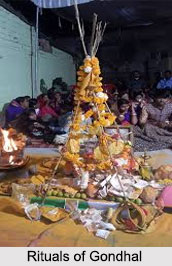 Gondhal is a Marathi folk theatre in the form of worship that is performed exclusively by a group of men as part of rituals after ceremonies like marriage or a new birth. The literal meaning of the word "Gondhal" is "commotion" which is the dramatic narration of mythical stories, praise of heroes or narration of folk legends. All these forms part of a ritual dedicated to different divinities. Gondhal is an educative, entertaining and important tradition. It is one of those few important folk arts of Maharashtra that has become an inseparable part of the lifestyle of the people.
Gondhal is a Marathi folk theatre in the form of worship that is performed exclusively by a group of men as part of rituals after ceremonies like marriage or a new birth. The literal meaning of the word "Gondhal" is "commotion" which is the dramatic narration of mythical stories, praise of heroes or narration of folk legends. All these forms part of a ritual dedicated to different divinities. Gondhal is an educative, entertaining and important tradition. It is one of those few important folk arts of Maharashtra that has become an inseparable part of the lifestyle of the people.
Origin of Gondhal
The tradition of Gondhal originates from the homage paid to the Mother Goddess by Parashuram. Once Parashuram killed a demon named "Betasur", cut off his head, sowed his arteries and veins through the crown of his head and made a musical instrument out of it. Making a sound from that instrument, he went toward Goddess Renuka and worshipped her.
Objectives of Gondhal
"Gondhal" is performed as a remedy to the suffering caused by age old spiritual defects in the premises and also to terminate distress caused by negative energies, continuing for generations. In order to reduce the suffering of other family members, caused by negative energies, the Goddess is awakened with a loud sound and is invoked to undertake Her mission of destruction.
 Rituals of Gondhal
Rituals of Gondhal
Gondhal takes place in front of the Yajamana"s i.e. host"s house. A wooden board on the ground is covered with a new cloth, on which rice or jowar grains are arranged in a square, in each corner a half coconut, betel nuts, dry dates, turmeric roots, a banana and betel leaves are placed. A pitcher filled with water, betel or mango leaves and whole coconuts are placed at the centre, near the idol of the Goddess. The Goddess is worshipped with flowers. Five stalks of jowar plants or sugar-cane sticks at each corner of the board have their heads tied together in a bunch above the pitcher. A string of thin wafer-like kadakanya i.e. sweet Puri and karanjya i.e. coconut pie, with a garland hanging over the pitcher are tied to the top, signifying the Goddess"s presence.
Performance of Gondhal
Gondhal varies between devotional singing and dramatic presentation of any Purana part. The singers are considered the counterparts of the Caranas, the Bhatas and the Pauranikas, who were also narrators and singers of epics and myths. It comprises a story from the Ramayana, Mahabharata, or the Puranas with several interpolations. The narration proceeds through dialogues, jokes, songs, dances and prose commentary, without any written script.
The main Gondhali dances and songs are fixed conventions, in circular, spinning movements, performing mudras with his fingers. The chief Gondhali, holding a flaming torch, has three to six comrades with musical instruments like tal or cymbals, sambaland chaundkedrums, conch, and the stringed tuntune. Other social and mythological songs are also delivered with equal interest.
Costumes for Gondhal
The chief Gondhali is dressed in a huge, knee-length garment requiring around 25 m of cloth, and wears a string of 64 cowrie shells and 64 silk gondas i.e. tassels set alternately and a kanganidar pagri i.e. tall turban. His companions wear traditional everyday dhotis.




















